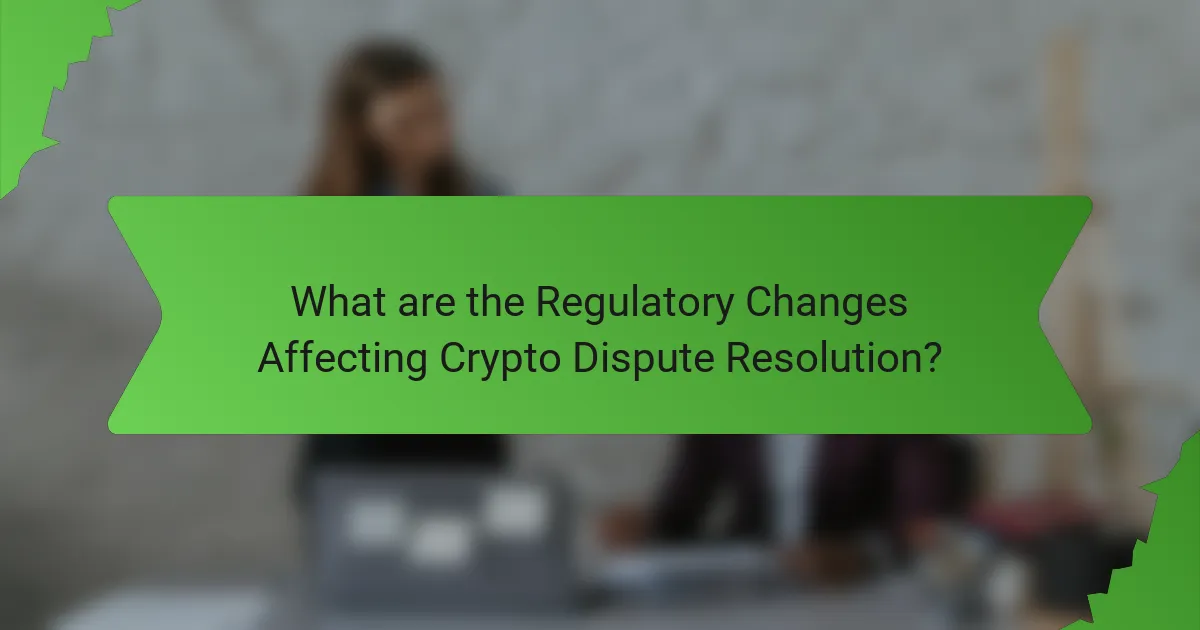Regulatory changes in the cryptocurrency sector are reshaping dispute resolution frameworks, emphasizing transparency and accountability for crypto exchanges. Key regulations, such as the Financial Action Task Force (FATF) guidelines and the European Union’s Markets in Crypto-Assets (MiCA) regulation, mandate compliance measures like Know Your Customer (KYC) and Anti-Money Laundering (AML) protocols, as well as clear dispute resolution processes. Current trends indicate a shift towards structured arbitration and the adoption of decentralized finance (DeFi) solutions, including smart contracts, which streamline dispute resolution. Additionally, there is a growing preference for alternative dispute resolution methods, such as mediation and negotiation, due to their efficiency and cost-effectiveness. Overall, these developments aim to enhance consumer protection and foster trust within the crypto market.

What are the Regulatory Changes Affecting Crypto Dispute Resolution?
Regulatory changes affecting crypto dispute resolution include new frameworks for handling disputes in the cryptocurrency sector. Recent regulations emphasize the need for transparency and accountability from crypto exchanges. For instance, the Financial Action Task Force (FATF) guidelines require crypto service providers to implement robust compliance measures. These measures include Know Your Customer (KYC) and Anti-Money Laundering (AML) protocols. Additionally, jurisdictions are increasingly mandating that exchanges provide clear dispute resolution processes. The European Union’s Markets in Crypto-Assets (MiCA) regulation also aims to standardize practices across member states. These changes seek to protect consumers and enhance trust in the crypto market. As a result, dispute resolution mechanisms are evolving to be more structured and formalized.
How do these regulatory changes influence the landscape of crypto dispute resolution?
Regulatory changes significantly influence the landscape of crypto dispute resolution by establishing clearer guidelines and frameworks. These regulations promote transparency in transactions, which can reduce disputes. They also provide a legal basis for resolving conflicts, enhancing trust among users. Additionally, regulatory bodies can offer mediation services, streamlining the resolution process. As a result, stakeholders are more likely to engage in the crypto market with confidence. For instance, the introduction of the Financial Action Task Force (FATF) recommendations has led to improved compliance measures among crypto exchanges. This compliance fosters a safer environment for dispute resolution. Overall, these changes create a more structured approach to addressing conflicts in the crypto space.
What specific regulations have been enacted recently?
Recent regulations enacted include the European Union’s Markets in Crypto-Assets (MiCA) framework. MiCA aims to provide a comprehensive regulatory approach to crypto assets. It establishes clear rules for crypto service providers and issuers. This regulation enhances consumer protection and market integrity. Additionally, the U.S. Securities and Exchange Commission has proposed new guidelines for digital asset securities. These guidelines clarify the classification of certain crypto assets. They aim to improve transparency and compliance in the crypto market.
How do these regulations differ across jurisdictions?
Regulations on crypto dispute resolution vary significantly across jurisdictions. Different countries have unique legal frameworks governing cryptocurrencies. For example, the United States follows a decentralized approach, with state-level regulations differing widely. In contrast, the European Union has proposed a more harmonized regulatory framework through the Markets in Crypto-Assets Regulation (MiCA).
Additionally, some countries like China have imposed strict bans on cryptocurrency activities. Meanwhile, nations such as El Salvador have adopted Bitcoin as legal tender. These variations impact how disputes are resolved, with some jurisdictions offering robust consumer protections and others lacking clear guidelines.
Overall, the differences in regulations influence the effectiveness and efficiency of crypto dispute resolution mechanisms.
Why are regulatory changes significant for crypto dispute resolution?
Regulatory changes are significant for crypto dispute resolution because they establish legal frameworks for resolving conflicts. These frameworks provide clarity on rights and obligations for all parties involved. Clear regulations help build trust among users and service providers in the crypto space. They also facilitate the enforcement of contracts and agreements. For instance, regulations can define jurisdiction and applicable laws in disputes. This reduces ambiguity and potential conflicts. Additionally, regulatory changes can enhance consumer protection measures. Such protections are crucial in an industry known for its volatility and risks. Overall, regulatory changes create a more structured environment for addressing disputes effectively.
What challenges do these changes present for stakeholders?
Regulatory changes in crypto dispute resolution present significant challenges for stakeholders. Stakeholders face increased compliance costs due to new regulations. These costs can strain smaller entities that lack resources. Additionally, there is a risk of legal uncertainty surrounding the interpretation of new rules. This uncertainty can lead to inconsistent application across jurisdictions. Stakeholders must also adapt to evolving technological requirements for compliance. Training personnel to understand these changes adds another layer of complexity. Furthermore, the potential for increased scrutiny from regulators may create operational hurdles. These challenges require stakeholders to invest time and resources to navigate the new landscape effectively.
How do regulatory changes impact consumer trust in crypto transactions?
Regulatory changes significantly influence consumer trust in crypto transactions. Clear regulations enhance transparency and security in the crypto market. When consumers perceive a regulatory framework, they feel more protected against fraud. For instance, regulations that require exchanges to implement Know Your Customer (KYC) practices can increase user confidence. Conversely, sudden or overly strict regulations may create uncertainty. This can lead to decreased trust among consumers who fear potential restrictions on their transactions. Historical data shows that regulatory announcements often lead to immediate fluctuations in market sentiment. Therefore, the nature and implementation of regulatory changes play a crucial role in shaping consumer perceptions of trust in crypto transactions.

What are the Implications of Regulatory Changes on Crypto Dispute Resolution?
Regulatory changes significantly impact crypto dispute resolution. They can establish clearer frameworks for resolving conflicts. This clarity can lead to increased trust among users and investors. Enhanced regulations may also promote the adoption of standardized practices in dispute resolution. This standardization can reduce ambiguity and streamline processes. Furthermore, regulatory oversight may encourage the development of specialized arbitration bodies. These bodies would be equipped to handle crypto-related disputes effectively. Overall, regulatory changes can foster a more secure environment for crypto transactions.
How do these implications affect users of crypto platforms?
Regulatory changes significantly affect users of crypto platforms by altering the legal landscape in which they operate. Users may experience increased security due to enhanced compliance measures. These measures can lead to better protection against fraud and scams. However, users might also face higher costs as platforms adjust to new regulations. Compliance often requires investment in technology and legal resources. Users may encounter limitations on transactions due to stricter Know Your Customer (KYC) and Anti-Money Laundering (AML) requirements. This can reduce the speed and convenience of transactions. Additionally, regulatory uncertainty can lead to market volatility, impacting user investments. Overall, these implications create a complex environment for crypto platform users.
What are the potential benefits for users in light of new regulations?
New regulations can enhance user protection in the crypto space. They may provide clearer guidelines for dispute resolution processes. This can lead to faster resolutions and reduced ambiguity. Users may benefit from increased transparency in transactions. Enhanced security measures may be mandated, reducing fraud risks. Regulatory compliance can also promote trust in the market. A more stable environment may encourage wider adoption of cryptocurrencies. Overall, these benefits can foster a safer and more reliable crypto ecosystem.
What risks do users face with ongoing regulatory changes?
Users face risks such as uncertainty and compliance challenges due to ongoing regulatory changes. These changes can lead to abrupt shifts in the legal landscape affecting cryptocurrency operations. Users may experience increased scrutiny from regulatory bodies, which can result in penalties or account freezes. Additionally, the lack of clarity in regulations can create confusion, making it difficult for users to comply. This uncertainty can deter investment and participation in the crypto market. According to a report by the Financial Action Task Force (FATF), regulatory inconsistencies can lead to a lack of trust in cryptocurrency systems. Users may also face risks related to data privacy and security as regulations evolve.
What role do regulatory bodies play in dispute resolution processes?
Regulatory bodies oversee and facilitate dispute resolution processes. They establish guidelines to ensure fair practices. These bodies often mediate disputes between parties. They provide a structured framework for resolving conflicts. Regulatory bodies also enforce compliance with industry standards. Their involvement can enhance trust in the resolution process. For example, the Financial Industry Regulatory Authority (FINRA) offers arbitration services for financial disputes. This involvement helps maintain market integrity and consumer protection.
How can regulatory bodies enhance dispute resolution frameworks?
Regulatory bodies can enhance dispute resolution frameworks by implementing standardized procedures and guidelines. Standardization ensures consistency in how disputes are managed across different cases. It also fosters transparency, allowing stakeholders to understand the processes involved. Additionally, regulatory bodies can provide training and resources for dispute resolution practitioners. This investment in human capital improves the quality of mediation and arbitration services. Furthermore, they can promote the use of technology to streamline dispute resolution processes. Digital tools can facilitate quicker communication and documentation. Finally, engaging stakeholders in the development of these frameworks ensures that the needs of all parties are addressed. This collaborative approach leads to more effective and equitable resolution mechanisms.
What are the best practices for compliance in crypto dispute resolution?
The best practices for compliance in crypto dispute resolution include establishing clear policies and procedures. Organizations should document all dispute resolution processes comprehensively. Training staff on regulatory requirements is essential for effective compliance. Utilizing technology to track and manage disputes enhances accountability. Regular audits of dispute resolution practices ensure adherence to regulations. Engaging legal experts familiar with crypto regulations can provide valuable guidance. Transparency in communication with all parties involved is crucial for trust. Finally, staying updated on regulatory changes helps maintain compliance.

What Insights Can Be Gained from Current Trends in Crypto Dispute Resolution?
Current trends in crypto dispute resolution indicate a shift towards increased regulatory oversight. This shift aims to enhance transparency and accountability in the crypto space. Regulatory bodies are implementing frameworks that require clearer guidelines for dispute resolution processes. These frameworks often include mandatory arbitration clauses and standardized procedures.
Moreover, the rise of decentralized finance (DeFi) platforms has prompted the need for innovative dispute resolution mechanisms. Smart contracts are being utilized to automate and resolve disputes efficiently. This technology reduces the need for intermediaries, thereby streamlining processes.
Additionally, trends show an increase in the use of mediation and negotiation as alternative dispute resolution methods. These methods are preferred for their cost-effectiveness and speed compared to traditional litigation. The growing acceptance of these methods reflects a broader trend towards user-centric solutions in the crypto ecosystem.
Overall, insights from current trends reveal a move towards more structured, efficient, and user-friendly dispute resolution in the cryptocurrency sector.
How are organizations adapting to regulatory changes in dispute resolution?
Organizations are adapting to regulatory changes in dispute resolution by implementing compliance frameworks. These frameworks ensure adherence to new regulations. They are also investing in training programs for staff on regulatory requirements. Many organizations are adopting technology solutions to streamline dispute resolution processes. This includes using automated systems for documentation and communication. Additionally, organizations are engaging with legal experts to navigate complex regulatory landscapes. They are also participating in industry forums to share best practices. These steps help organizations remain responsive and proactive in a changing regulatory environment.
What innovative practices are emerging in response to regulatory shifts?
Innovative practices emerging in response to regulatory shifts include the adoption of decentralized dispute resolution platforms. These platforms utilize blockchain technology to ensure transparency and immutability in the resolution process. Smart contracts are increasingly being integrated to automate enforcement of agreements, reducing reliance on traditional legal systems. Additionally, some companies are developing hybrid models that combine arbitration with blockchain to enhance efficiency. Regulatory compliance tools are also being created to help businesses navigate changing laws and ensure adherence. Collaborative frameworks between regulators and industry stakeholders are emerging to foster innovation while maintaining compliance. These practices reflect a proactive approach to adapting to new regulatory landscapes in the crypto space.
How can organizations leverage technology to improve dispute resolution?
Organizations can leverage technology to improve dispute resolution by utilizing digital platforms for communication and documentation. These platforms allow for real-time collaboration among parties involved in a dispute. Automated systems can streamline the process by managing case files and tracking progress. Technologies like artificial intelligence can analyze data to predict outcomes and suggest resolutions. Blockchain technology can enhance transparency and trust by providing immutable records of transactions and agreements. According to a study by the International Institute for Conflict Prevention and Resolution, these technological advancements can significantly reduce the time and costs associated with traditional dispute resolution methods.
What strategies can stakeholders implement to navigate regulatory changes effectively?
Stakeholders can implement proactive monitoring of regulatory developments to navigate changes effectively. This involves staying informed about emerging regulations through industry news and government announcements. Stakeholders should also engage in continuous education and training for their teams. This ensures that employees understand the implications of new regulations. Furthermore, establishing relationships with regulatory bodies can facilitate open communication. Stakeholders can also collaborate with industry associations to share insights and best practices. Adopting flexible business models allows for quick adjustments to regulatory shifts. Finally, conducting regular compliance audits helps identify gaps in adherence to new regulations. These strategies collectively enhance stakeholders’ ability to adapt to regulatory changes in the crypto landscape.
What key considerations should stakeholders keep in mind?
Stakeholders should prioritize compliance with evolving regulations. Understanding the legal landscape is crucial for effective dispute resolution. Stakeholders must also consider the implications of regulatory changes on operational practices. Engaging with regulatory bodies fosters better communication and compliance. Assessing the potential impact on consumer protection is essential. Stakeholders should evaluate the cost implications of new regulations. Collaborating with legal experts can provide valuable insights. Monitoring industry trends aids in proactive adaptation to changes.
How can stakeholders prepare for future regulatory developments?
Stakeholders can prepare for future regulatory developments by staying informed about potential changes. They should actively monitor legislative updates and industry news. Engaging with regulatory bodies can provide insights into upcoming regulations. Participating in industry associations helps stakeholders understand collective challenges and responses. Developing compliance strategies early can mitigate risks associated with new regulations. Investing in legal expertise ensures that stakeholders can navigate complex regulatory landscapes. Regular training for staff on compliance can enhance organizational readiness. Lastly, adopting flexible business models allows stakeholders to adapt quickly to regulatory shifts.
What best practices should be followed for effective crypto dispute resolution?
Effective crypto dispute resolution requires clear communication, documented agreements, and adherence to established protocols. Parties should maintain thorough records of all transactions. This includes timestamps, transaction IDs, and correspondence. Utilizing smart contracts can automate terms and conditions, reducing ambiguity. Engaging neutral third-party mediators can facilitate discussions and offer unbiased perspectives. Establishing a clear escalation process ensures disputes are resolved promptly. Regularly reviewing and updating dispute resolution policies aligns with evolving regulations. These practices enhance transparency and trust among users, fostering a safer crypto environment.
The primary entity of this article is regulatory changes in the context of crypto dispute resolution. The article examines how recent regulations, such as the European Union’s Markets in Crypto-Assets (MiCA) framework and the Financial Action Task Force (FATF) guidelines, are shaping dispute resolution processes within the cryptocurrency sector. It discusses the implications of these changes for stakeholders, including enhanced compliance requirements, variations across jurisdictions, and the effects on consumer trust. Additionally, it highlights emerging trends and best practices in dispute resolution, emphasizing the role of technology and regulatory bodies in fostering a more structured and secure environment for crypto transactions.




